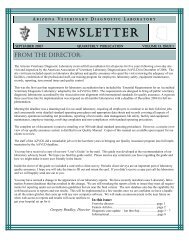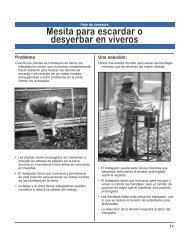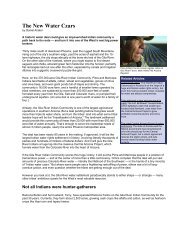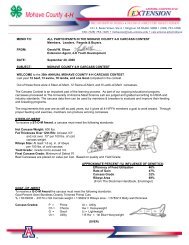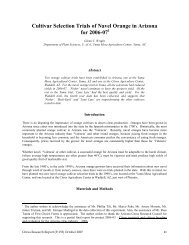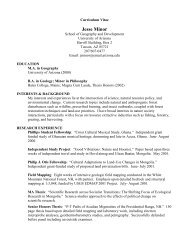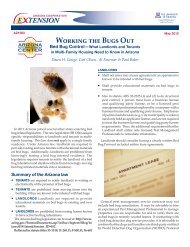Evaporative cooler water use - University of Arizona
Evaporative cooler water use - University of Arizona
Evaporative cooler water use - University of Arizona
You also want an ePaper? Increase the reach of your titles
YUMPU automatically turns print PDFs into web optimized ePapers that Google loves.
and result in insufficient air flow and more noise. Also<br />
from the utility standpoint, the <strong>use</strong> <strong>of</strong> both systems<br />
results in an enhancement <strong>of</strong> the peaking problem for<br />
both <strong>water</strong> and power suppliers and, therefore, contribute<br />
to the need for additional capacity <strong>of</strong> these systems<br />
which are poorly utilized in <strong>of</strong>f-peak demand periods.<br />
For systems using shared ductwork, dampers must<br />
be installed to separate the two units. Without dampers,<br />
refrigerated air will escape to the outside through the<br />
evaporative <strong>cooler</strong> and, conversely, moist air from the<br />
evaporative <strong>cooler</strong> will enter and corrode the refrigeration<br />
unit. Many systems have dampers that are automatic.<br />
They should be checked annually for correct<br />
operation.<br />
Care must be <strong>use</strong>d when operating the evaporative<br />
<strong>cooler</strong> and refrigeration unit alternately. The refrigeration<br />
system will work much harder than normal since it<br />
has to remove the moisture brought into the ho<strong>use</strong> by<br />
the evaporative <strong>cooler</strong>. Moisture from the <strong>cooler</strong> will<br />
condense on the refrigeratant coil and increase electrical<br />
costs appreciably; therefore, one should not directly<br />
precool air to be refrigerated. 6<br />
4. Where are <strong>cooler</strong>s typically placed on a building?<br />
<strong>Evaporative</strong> <strong>cooler</strong>s can be classified according to<br />
the position <strong>of</strong> the <strong>cooler</strong> in relation to the building.<br />
Generally, there are three types: (a) down-draft (ro<strong>of</strong><br />
mounted), (b) side-draft (typically eave or window<br />
mounted), and (c) up-draft (ground mounted).<br />
Ro<strong>of</strong> mounted, down-draft <strong>cooler</strong>s (a) are sometimes<br />
preferred since they can usually be more readily<br />
connected to duct systems and are out <strong>of</strong> the way on<br />
the ro<strong>of</strong>. However, eave mounted (b) or ground<br />
mounted (c) units can be more easily and safely serviced<br />
since the person doing the maintenance does not<br />
have to <strong>use</strong> a ladder to inspect or repair the system.<br />
5. Are there any <strong>cooler</strong>s on the market that <strong>use</strong> less<br />
<strong>water</strong> than others?<br />
The <strong>use</strong> <strong>of</strong> <strong>water</strong> by <strong>cooler</strong>s is generally dependent<br />
on their size, air movement and relative humidity <strong>of</strong> the<br />
air. Therefore, all things being equal, a 4500 CFM<br />
<strong>cooler</strong> <strong>use</strong>s less <strong>water</strong> than a 6000 CFM <strong>cooler</strong>. Research<br />
is showing that some units appear to more<br />
efficiently evaporate <strong>water</strong> and, thus, produce more<br />
cooling per unit <strong>of</strong> <strong>water</strong> <strong>use</strong>. 7<br />
6. I need a new <strong>cooler</strong>, but I don’t know what size to<br />
buy.<br />
A simple formula can help you decide. First, you’ll<br />
need to determine your home’s cubic footage. Multiply<br />
the square footage (length by width) <strong>of</strong> the floor area<br />
by the ceiling height and divide by two. For example, a<br />
1600 square foot home multiplied by a ceiling height<br />
<strong>of</strong> eight feet is 12,800 cubic feet, divided by two is<br />
6400. An evaporative <strong>cooler</strong> with a CFM number<br />
closest to 6400 should be adequate for your home.<br />
CFM are usually clearly marked on the front <strong>of</strong> the<br />
<strong>cooler</strong>. Consult with your <strong>cooler</strong> supplier about <strong>cooler</strong><br />
size. Too large or too small <strong>cooler</strong>s are wasteful <strong>of</strong> both<br />
<strong>water</strong> and energy and will not provide the comfort or<br />
efficient <strong>use</strong> <strong>of</strong> resources you are seeking for your<br />
home.<br />
7. Should I buy a <strong>cooler</strong> with a two-speed motor?<br />
The advantage <strong>of</strong> a two-speed system is that low<br />
speed can be <strong>use</strong>d at night when exterior temperatures<br />
drop or on days when temperatures are not excessive.<br />
Low speed could also be <strong>use</strong>d during the day when<br />
family members are working. When family members<br />
return home, high speed would quickly lower the<br />
temperature. Coolers usually run more quietly at low<br />
speed and provide about 66 percent <strong>of</strong> the airflow <strong>of</strong><br />
<strong>Arizona</strong> Cooperative Extension • 3



